
Frederick William Brearey (active c.1860s - 1890s)Hon. Sec. RAeS (Royal Aeronautical Society) 1865 - c.1895
The Dominion of the Air The section of our countrymen specially interested in aeronautics--a growing community--is represented by the Aeronautical Society, formed in 1865, with the Duke of Argyll for president, and for thirty years under the most energetic management of Mr. F. W. Brearey, succeeding whom as hon. secs. have been Major Baden-Powell and Mr. Eric S. Bruce. Mr. Brearey was one of the most successful inventors of flying models. Mr. Chanute, speaking as President of the American Society of Civil Engineers, paid him a high and well-deserved compliment in saying that it was through his influence that aerial navigation had been cleared of much rubbish and placed upon a scientific and firm basis.
Progress in Aviation The propulsion of a loose undulating surface was at about the same time, somewhat differently and quite independently, proposed by M. F. W. Brearey, the Honorary Secretary of the Aeronautical Society of Great Britain. He patented, in 1879 the apparatus shown in fig. 60, in which a flexible fabric is attached to a central spine and to vibrating wing arms at the front, which latter beat up and down like the wings of a bird. The effect of this action is to throw the fabric into a state of wavelike motions, both lengthwise and in a smaller degree also laterally, which are said to cause the apparatus to be both supported and propelled in the air, while an adjustable tail regulates the angle of incidence. The wing arms are flexible and stayed to a bowsprit by cords, and the power for an actual machine is to be placed in a car or body affixed along the central spine.
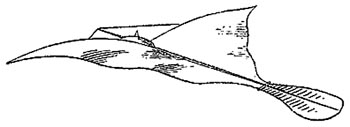 fig 60. Brearey design of 1879
M. Brearey records that he took the idea from watching the movements of a "skate" fish in an aquarium, which in swimming undulated its whole body, and that he found that when applied to propulsion in air the loose fabric greatly added to the stability, so that the device might be considered as a sort of dirigible parachute, which would come down safely if the motive power became exhausted from any cause. In the various models which he made to illustrate the experimental lectures, with which he was accustomed to popularize 'the problem of flight' in Great Britain, he used the torsion of indict-rubber to produce the revolution of the crank which vibrated the arms, thus getting a dozen strokes or so, and he claimed that the smaller model (5 ft. X 8 ft.) flew from his hand, on one occasion at least, perfectly horizontally to the extent of 60 ft., no angle of incidence of the apparatus being perceptible.
Aerial ApparatusUnited States Patent #234,947 : 1880-11-30Brearey, Frederick W., Blackheath, Kent, England
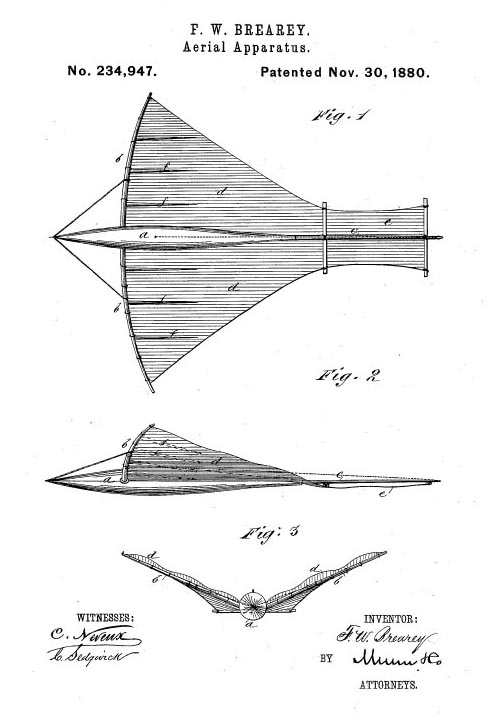 Brearey Patent of 1880 Click to enlarge
The larger model was 6 ft. wide by 10 ft. long, with about 16 sq. ft. of surface, and a weight of 3.1 lbs. (of which 0.44 lbs was added ballast, which it easily carried), being thus in the proportion of some 5.15 sq. ft. per pound of weight, with which the falling velocity would be about 9 ft. per second, or equal to a descent from a height of 1.27 ft., but which was nevertheless found to be too heavy to be safely used in public experiments over the heads of an audience. From his experiments M. Brearey drew the following conclusions as to the possibilities of his apparatus:
We are thus at liberty to contemplate the construction of an aerial vehicle whose dimensions would suffice to maintain, in wave-action, 600 or 700 sq. ft. of canvas, actuated by steampower, and capable of supporting the additional weight of a man, whose weight, together with the machine, would certainly not exceed 500 lbs.; and we can contemplate the man as being able to move a few feet backward or forward without much affecting the stability of the machine. His descent under the parachute action can thus be graduated at will. This can also be effected by a cord attached to the tail, which by that means can be elevated or depressed at pleasure. Placed upon wheels it has, of course, yet to be ascertained what distance of pre. liminary run would be required, assisted by the action of the fabric, before it would rise from the ground. Subsequently (his second American patent is dated in 1885 M. Brearey further proposed the superposition of two or more sets of such "wave-action" aeroplanes, and the important addition of what he calls the "pectoral cord," which consists in an elastic cord (or suitable spring) attached to some point underneath each of the lower set of wing-arms and passing underneath the carriage, car or central spine, so that it may be thrown into tension on the up stroke, and restore the power thus stored upon the down stroke of the wing-arms.
Apparatus for effecting Aerial NavigationUnited States Patent #320,042 : 1885-06-15Brearey, Frederick W., Blackheath, Kent, England
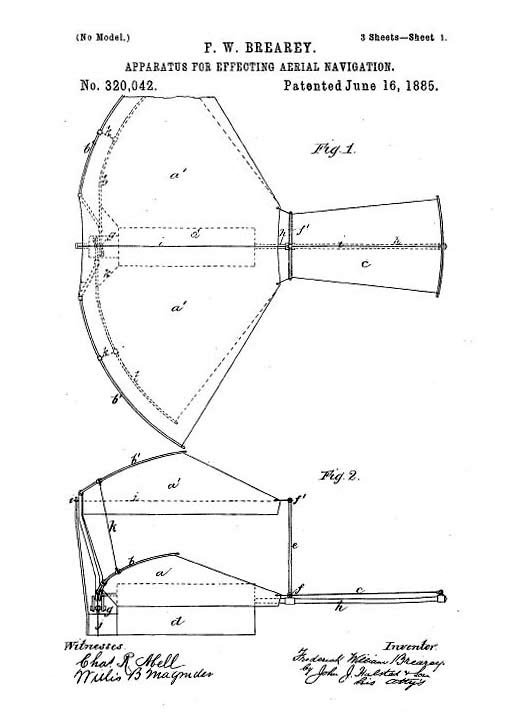 Brearey Patent of 1885, p.1 Click to enlarge
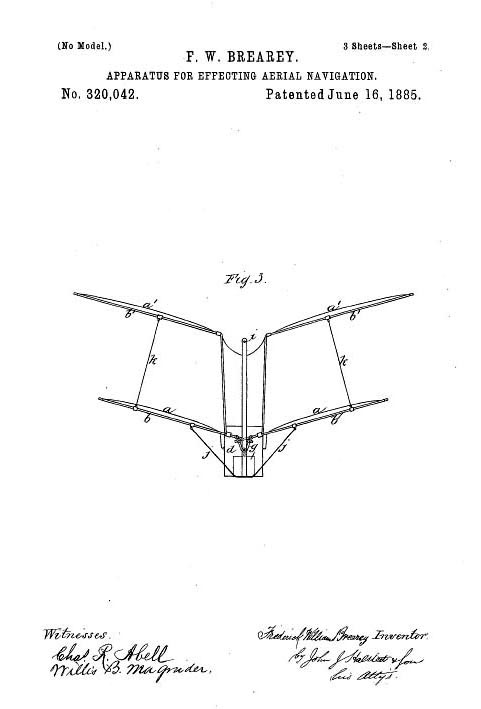 Brearey Patent of 1885, p.2 Click to enlarge
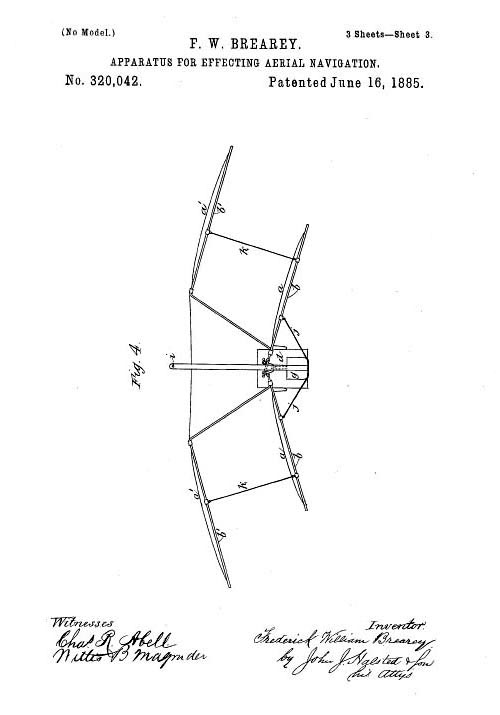 Brearey Patent of 1885, p.3 Click to enlarge
This device is designed to imitate in its action the functions of the pectoral muscle of a bird. The tension of this cord or spring is regulated in accordance with the weight to be sustained, and is said to be perfect when, upon the whole apparatus being committed free to the air, the wing-arms are retained at a suitable diedral angle against the upward pressure. It follows from this action that the up stroke, being assisted by the air pressure which sustains the weight of the apparatus, expends less power than the down stroke, and that nearly all the power can be used in depressing the wing-arms to compress a wave of air, which undulating backward and outward along the loose fabric may assist the air pressure already due to the forward speed in sustaining the aeroplane, and serve at the same time to propel it. M. Brearey, however, seems to have applied this "pectoral cord" chiefly to those of his models which showed the wing-action proper, and in the practical demonstration which he gave to the Aeronautical Society of Great Britain, at its meeting in 1882 he said:
Working in the field of experiment, I am enabled to state that the power requisite to propel and-sustain a body in the air has been greatly overestimated, even by those who took the more favorable estimate in view of the ultimate attainment of flight. I am not aware, however, that the true reason for the minimum display of actual power exerted in the flight of birds has ever been propounded. Certainly it has never before been demonstrated by actual experiment. The action of the pectoral muscles of the bird alone accounts for this. Consequently the advantage would be altogether lost in anything but a reciprocal action. The bird commits himself to the air, and the pressure of the air underneath the wings forces them upward. The weight of the bird is indicative of the pressure; and as a consequence of this automatic raising of the wing by the pressure of the air underneath, we should imagine that the elevator muscle need not be strong. As a matter of fact, we find it is weak. I doubt whether any muscular effort is made to elevate the wing at all in flight, but when not in flight, the bird of course requires the power to elevate its wing in preparation for it. Committed, then, to the air, the elastic ligaments connected with the winks are stretched to that degree which allows of the wings being sufficiently raised for effective support without flapping, and without, as I conceive, any muscular exertion upon the part of the bird. The limited power of the elevator muscle may here come into use occasionally in aid of the under air-pressure, and with the further effect of stretching the ligaments. Now it will be argued that' in the downward stroke there must be as much muscular force employed as will raise or, at least, prevent from falling, the weight of the bird; but this is not so, because the reaction of these ligaments, which have been stretched entirely by the weight of the bird, assists materially the action of the depressor muscle.M. Brearey here produced a model having wings measuring 4 ft. from tip to tip. He showed the elastic cord underneath the wings but for the purpose of the first experiment he detached it. He then wound up the indict-rubber strands 32 times, and showed that this, although sufficient to flap the wings with energy while held in the hand, was insufficient to cause the model to fly. This was demonstrated by letting the model free. He explained its inability to fly from its want of power to bring the wings down with sufficient force. He now unwound the action and proceeded to wind it up again 32 times, and attached the pectoral cord. Holding the model in his hand, he called attention to the fact that it was powerless to flap the wings because the two forces were in equilibrium. It required the addition of another force to effect flight, and he asked what that other force could be except weight? If now It flew, he proved beyond the possibility of doubt that weight was a necessity for flight. The model was then set free, and flight was accomplished. He also showed that the model would only fly without the attached pectoral cord when wound up 40 times. With the cord it would fly when wound up only 13 times, thus showing the great saving in power which accrued through the action of the pectoral cord. M. Brearey then produced a model of his "wave aerial machine," having 4 sq. ft. of loose surface weighted to 1/2 lb., and he demonstrated by its flight that the principle was equally applicable to that. It may be questioned whether this "wave action" is likely to prove economical of power in either sustaining or propelling an aeroplane, for it seems difficult to conceive that a wave of air compressed at the front by the wing arms should travel back to the rear, unconfined as it is either at the bottom or sides. Still, the loose surface may add to the stability, as claimed for the Dandrieux toy, and it would certainly diminish by its yielding the strains that would otherwise occur at the points of attachment of a rigid surface in an aeroplane; but M. Brearey's wave action seems to be chiefly applicable as a dirigible parachute, and a small model upon this principle, but without motive power, was once liberated as an experiment by Captain Templer, from a balloon which had risen 200 ft. or 300 ft. from Woolwich Arsenal, and it traveled back again to the arsenal, half a mile, against the wind. It seems somewhat singular that so few efforts have been made to devise dirigible parachutes, a system which M. de Ia Landelle constantly extolled, as constituting the first requisite step toward eventual flight by working out the problem of absolute stability and safety. The only one of these devices which the writer has been able to find recorded is that of M. Couturier, patented in France in 1875 and this is so briefly described in the Aéronaute for November, 1878 that its mode of operation cannot be made out. The "pectoral cord" attachment is probably a valuable device for flapping wings, as furnishing that inequality of effort between the up and the down stroke which undoubtedly obtains in bird flight. This effect was produced in a "wave-action" model exhibited by M. Brearey at the aeronautical exhibition of the Aeronautical Society of Great Britain of 1885 by a "trunk engine" designed and built by M. Hollands, which, however, was not shown under steam, as the boiler was only just completed in time for the exhibition; but M Hollands said that the model flew well, and supported weights, when the engine was supplied with compressed air through an indict-rubber tube. He does not seem to have stated what power was exerted. While almost all inventors and experimenters of aeroplanes have proposed some sort of motive power, and have found their designs paralyzed very soon by the want of a sufficiently light motor, there have been at various times, as already intimated, keen observers of the flight of soaring birds, who have held that once under way in a sufficient breeze, the performance involves no muscular movement whatever, save in balancing, and that the wind alone furnishes sufficient motive power (if blowing from lo to 30 miles per hour) to enable man to soar and to translate himself at will in any direction even (paradoxical as it may seem) against the wind itself.
|
© Copyright 1999-2002 CTIE - All Rights Reserved - Caution |